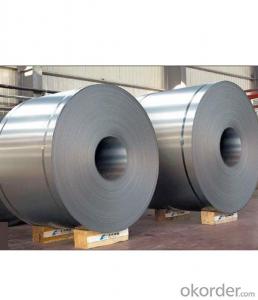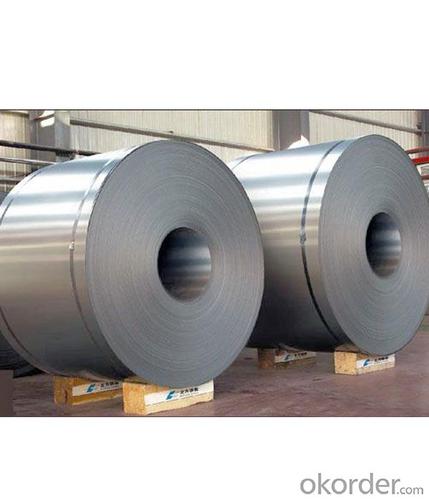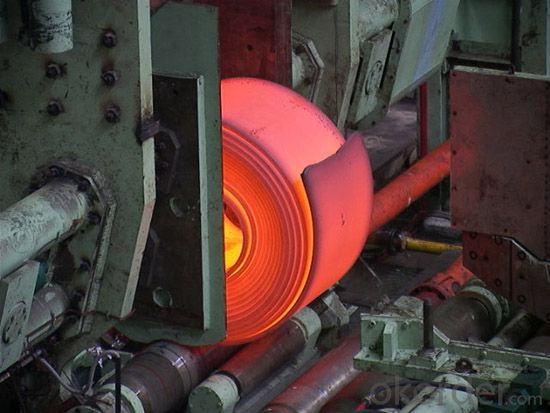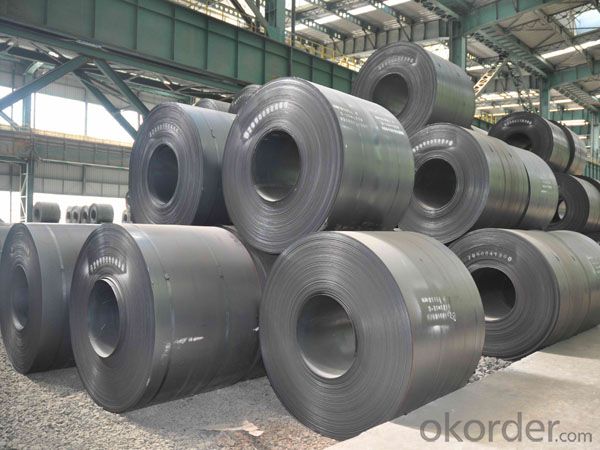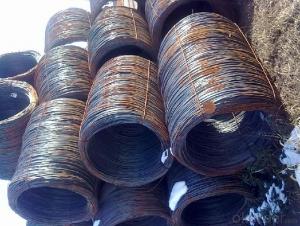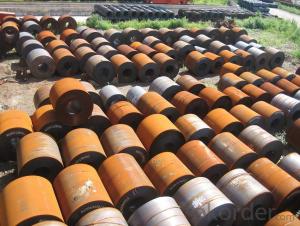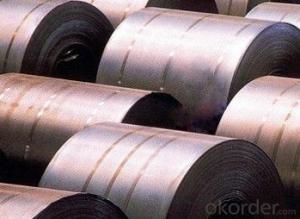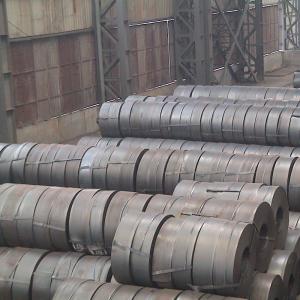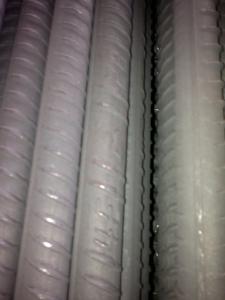Hot- rolled steel coil for construction GB Q235
- Loading Port:
- Tianjin
- Payment Terms:
- TT OR LC
- Min Order Qty:
- 25 m.t.
- Supply Capability:
- 100000 m.t./month
OKorder Service Pledge
OKorder Financial Service
You Might Also Like
Product Description:
One, introduction
Hot rolled coil is used for continuous casting slab or slab as raw material, after reheating furnace heating, scales entered the roughing mill in the high pressure water, roughing cut is expected by the head, tail, and then enter the finishing mill, the implementation of the computer controlled rolling, finally after rolling through the laminar cooling (computer controlled cooling rate) and coiling machine coiling, become straight hair volume. Hair straightener roll head, tail often forms a tongue shape and fishtail, thickness, width of poor accuracy, edge has wavy, folding, tower and other defects. The volume weight heavier, steel coil diameter is 760mm. (general pipe industry like use. )
2 two, characteristics
Because there is no after annealing treatment, the hardness is very high (HRB greater than 90), mechanical processing performance is poor, only a simplebending process has less than 90 degree directional (direction perpendicular to the rolled).
Three, use 3
Hot rolled products with high strength and good toughness, easy processing and good forming can be excellent performance of welding, which is widely used in ships, cars, bridges, buildings, machinery, boiler, pressure vesselmanufacturing industry.
The scope of application:
(1) after annealing processing into the common cold;
(2) processing galvanized galvanized unit before the annealing treatment;
(3) the basic do not need to process the panel.
4 four, classification
Carbon steel plate, carbon plate, low alloy plate, ship plate, bridge plate, boiler plate, container plate etc.. Rolling hard volumes: under normal temperature,the hot pickling volumes of continuous rolling.
Hot rolled steel strip products include steel (roll) and the shear of steel plate.And steel (coils) can be divided into straight and finishes volume (the volume,smooth rolling and slitting roll).
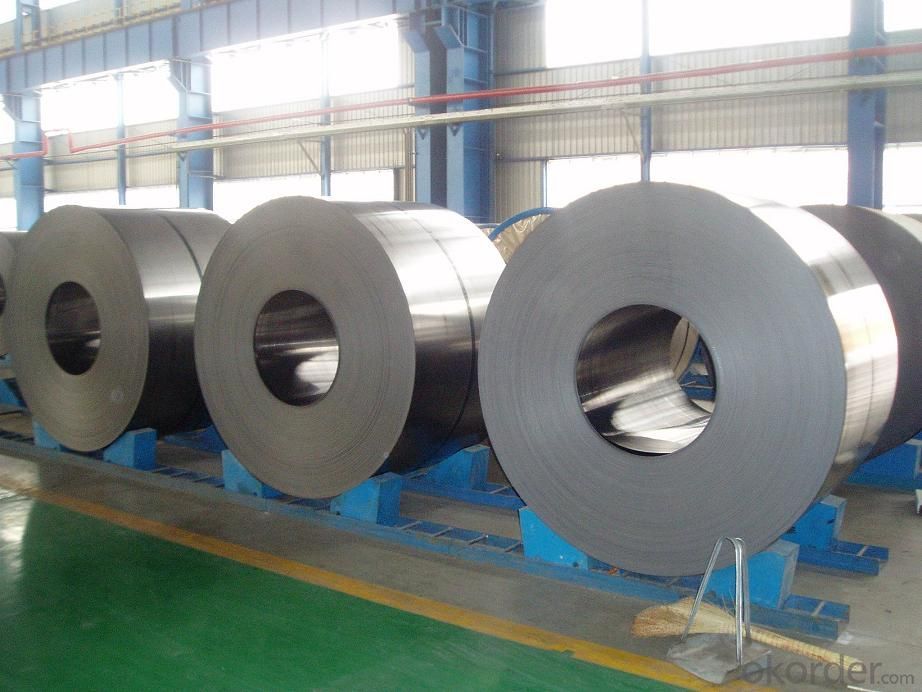
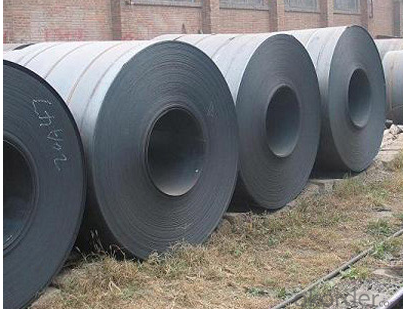
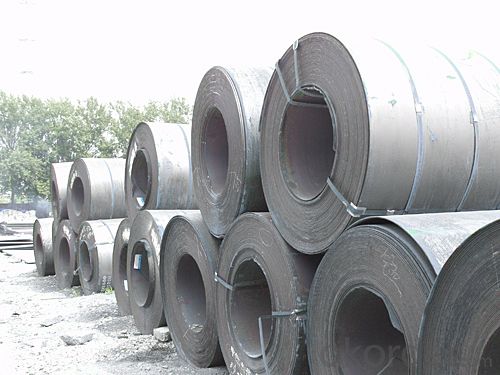
- Q: How are steel wire rods used in the production of fencing?
- The production of fencing involves the use of steel wire rods in multiple ways. Initially, these rods are the primary material for manufacturing the wires that compose the fencing structure. They are typically made from high-quality steel, which imparts strength and durability to the fencing. To initiate the production process, the steel wire rods undergo an initial cleaning and coating to prevent rusting and corrosion. Next, they are passed through a series of machines that draw them down to the desired thickness and shape. This drawing process enhances the wire's tensile strength, making it suitable for fencing purposes. Once the wire has been drawn, it undergoes further processing to create various types of fencing products. For instance, some wire rods are twisted or braided together to form chain-link fencing. These interwoven wires create a mesh-like pattern commonly used to secure residential or commercial properties. Typically, the wire rods used for chain-link fencing are galvanized or coated with PVC to increase their longevity and resistance to weathering. In addition to chain-link fencing, steel wire rods are also utilized in the production of welded wire mesh fencing. This type of fencing consists of a grid-like pattern formed by welding intersecting steel wires together. The wire rods used for welded wire mesh fencing are usually galvanized or coated with zinc to prevent rust and corrosion. In summary, steel wire rods are vital in the production of fencing as they provide the raw material necessary to create sturdy, durable, and secure fences. Their versatility allows for the manufacturing of various types of fencing, catering to different needs and requirements in both residential and commercial settings.
- Q: How is steel wire rod used in the manufacturing of wire forms for HVAC systems?
- Steel wire rod is an essential component in the manufacturing of wire forms for HVAC systems. These wire forms are key elements that provide structural support and stability to the HVAC system. Firstly, steel wire rod is used to produce the actual wire used in wire forms. The rod is typically made of high-quality steel, which ensures the wire's strength and durability. The rod is then processed through various manufacturing techniques such as drawing, annealing, and coating to create the desired wire diameter and properties. Once the wire is formed, it can be utilized in different ways within HVAC systems. For instance, it can be used to create wire forms that are used as support structures for air ducts. These wire forms provide a sturdy framework that maintains the shape and integrity of the ductwork. Additionally, steel wire rod can be used to manufacture wire forms that act as reinforcement for HVAC components. For example, it can be used to create wire grids that are placed behind air filters to enhance their structural stability and prevent them from collapsing under pressure. Wire forms made from steel wire rod can also be used as fasteners or connectors within HVAC systems. They can be shaped into hooks, clips, or springs that hold various components together, ensuring a secure and reliable connection. The use of steel wire rod in the manufacturing of wire forms for HVAC systems provides several benefits. Steel is known for its strength and durability, making it an ideal material for withstanding the harsh conditions often encountered in HVAC applications. It also has excellent corrosion resistance, ensuring the longevity of the wire forms in different environments. In conclusion, steel wire rod is an indispensable material in the manufacturing of wire forms for HVAC systems. Its strength, durability, and versatility make it a suitable choice for creating wire forms that provide structural support, reinforcement, and fastening mechanisms within HVAC systems.
- Q: What are the main challenges in manufacturing steel wire rod?
- Manufacturing steel wire rod presents several primary challenges. Consistent quality and uniformity in production prove to be one of these challenges. This necessitates strict control over the steel's chemical composition and mechanical properties, as any deviation can impact the final product's performance and reliability. Consequently, adherence to quality control procedures and continuous monitoring throughout the manufacturing process become essential. Another hurdle is achieving the desired dimensional accuracy and surface finish of the wire rod. This requires precise regulation of temperature and speed during the rolling process to ensure proper shape and size. Any irregularities or defects in the wire rod can compromise its strength and durability, rendering it unsuitable for intended applications. Balancing high production rates with safety and minimizing downtime also poses a significant challenge. Complex machinery and equipment used in steel wire rod manufacturing necessitate regular maintenance and monitoring to prevent breakdowns. Additionally, ensuring worker safety in this environment requires the implementation of strict safety protocols and the provision of appropriate safety equipment. Environmental sustainability is yet another challenge in steel wire rod manufacturing. The production process consumes substantial energy and emits greenhouse gases. To reduce the industry's environmental impact, energy-efficient technologies must be implemented, waste materials should be recycled and reused, and sustainable practices adopted throughout the entire production chain. Moreover, the steel wire rod industry faces the challenge of increasing competition and fluctuating market demands. Manufacturers must remain up-to-date with market trends, adapt to changing customer requirements, and constantly innovate to stay competitive. This involves investing in research and development to enhance product quality, develop new alloys, and explore alternative manufacturing methods. In conclusion, addressing challenges related to quality control, dimensional accuracy, safety, environmental sustainability, and market competitiveness is crucial in manufacturing steel wire rod. Overcoming these challenges requires a combination of advanced technology, a skilled workforce, and continuous improvements in manufacturing processes.
- Q: How is steel wire rod used in the manufacturing of wire connectors?
- Steel wire rod is used in the manufacturing of wire connectors as it serves as the raw material. The wire rod is processed and shaped to form the conductive components of the connectors, ensuring a secure and reliable electrical connection.
- Q: How is steel wire rod used in the production of electrical cables?
- Steel wire rod is used in the production of electrical cables as it serves as the core strength component. It provides structural support and enhances the durability and tensile strength of the cable. The steel wire rod is typically wrapped around the conductor and acts as a protective layer, preventing the cable from stretching or breaking under tension. Additionally, it helps to maintain the shape and integrity of the cable, ensuring reliable transmission of electricity.
- Q: What are the different tensile strengths available for steel wire rod?
- The tensile strengths available for steel wire rod vary depending on the specific grade and composition of the steel. Common tensile strengths for steel wire rod range from 400 MPa (megapascals) to 1200 MPa, with some specialty grades reaching even higher strengths.
- Q: What are the main factors affecting the market innovation of steel wire rod?
- The main factors affecting the market innovation of steel wire rod include technological advancements, changes in consumer demand, competition within the industry, government regulations and policies, and the availability and cost of raw materials.
- Q: How is steel wire rod recycled at the end of its lifecycle?
- Steel wire rod is typically recycled at the end of its lifecycle through a process called steel scrap recycling. This involves collecting the steel wire rod scrap from various sources such as manufacturing waste, construction sites, and end-of-life products. The collected scrap is then sorted and cleaned to remove any contaminants. Next, the scrap is melted down in electric arc furnaces or basic oxygen furnaces to produce molten steel. Subsequently, the molten steel is cast into new wire rod shapes through processes like continuous casting or hot rolling. Finally, the newly produced wire rod is used in various industries to manufacture different products, ensuring a sustainable and efficient utilization of steel resources.
- Q: What are the different surface defects that can impact the bending properties of steel wire rod?
- Some of the different surface defects that can impact the bending properties of steel wire rod include cracks, pits, scratches, and uneven surfaces. These defects can weaken the overall structure of the wire rod and affect its ability to withstand bending forces without breaking or deforming.
- Q: What are the safety requirements for steel wire rod used in ski lift wire ropes?
- The safety requirements for steel wire rod used in ski lift wire ropes are crucial to ensure the safe and reliable operation of ski lifts. These requirements are designed to minimize the risk of accidents and maintain the structural integrity of the wire ropes. Firstly, the steel wire rod used in ski lift wire ropes must meet specific material standards. It should be made from high-quality, high-strength steel that is capable of withstanding the tension and stress encountered during ski lift operations. The wire rod should adhere to international standards such as ASTM A1023/A1023M or EN 12385, which specify the minimum mechanical properties and chemical composition of the wire rod. In addition to material requirements, the wire rod must undergo rigorous testing and inspection processes. This includes non-destructive testing techniques like ultrasonic examination, magnetic particle inspection, and visual inspection to identify any defects or imperfections in the wire rod. The testing should be performed by certified and qualified personnel to ensure accuracy and reliability. Furthermore, the wire rod used in ski lift wire ropes must have a specific diameter and tolerance range to maintain the desired strength and performance. Ski lift manufacturers typically provide specifications that dictate the required diameter and tolerance for the wire rod to be used in their systems. These specifications should be followed closely to ensure compatibility and safety. It is also essential to consider the surface requirements of the wire rod. The wire rod should have a smooth and clean surface, free from any burrs, cracks, or other surface defects that could compromise the structural integrity of the ski lift wire ropes. Any surface irregularities should be addressed through appropriate surface treatments or inspections. Lastly, regular maintenance and inspection of the ski lift wire ropes are necessary to ensure ongoing safety. This includes visual inspections, lubrication, and tension checks to detect any signs of wear, corrosion, or fatigue. If any issues are identified, immediate action should be taken to repair or replace the affected wire ropes to prevent accidents or failures. Overall, the safety requirements for steel wire rod used in ski lift wire ropes encompass material standards, testing, dimensional specifications, surface quality, and ongoing maintenance. Adhering to these requirements ensures the reliability and safety of ski lifts, providing a secure and enjoyable experience for skiers.
Send your message to us
Hot- rolled steel coil for construction GB Q235
- Loading Port:
- Tianjin
- Payment Terms:
- TT OR LC
- Min Order Qty:
- 25 m.t.
- Supply Capability:
- 100000 m.t./month
OKorder Service Pledge
OKorder Financial Service
Similar products
Hot products
Hot Searches
Related keywords
